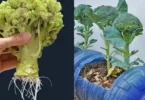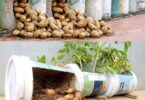Growing strawberries in containers like 5L plastic bottles can be a fun and rewarding gardening project. Here’s a step-by-step guide to help you get started:
Materials Needed:
- 5L plastic bottles (clean and with the tops removed)
- Strawberry plants or seeds
- Potting soil mix
- Fertilizer
- Pebbles or small stones for drainage
- Scissors or a utility knife
- Watering can or spray bottle
- Sunlight
Steps:
- Prepare the Bottles:
- Clean the plastic bottles thoroughly and remove their tops.
- Cut or drill several holes at the bottom of each bottle to provide drainage. This prevents water from accumulating and causing root rot.
- Prepare the Soil:
- Use a good quality potting soil mix that is well-draining and rich in nutrients.
- Fill the bottles about three-fourths full with the potting soil. Leave some space at the top to avoid overflow when watering.
- Plant the Strawberries:
- You can either use strawberry plants from a nursery or start from seeds. If using seeds, follow the instructions on the seed packet for germination.
- If using plants, gently remove them from their nursery pots and place them in the prepared bottles. Make sure the roots are spread out and not cramped.
- Position the Containers:
- Place the containers in a sunny spot where the strawberries will receive at least 6-8 hours of direct sunlight each day. If you’re growing indoors, place the containers near a sunny window or use artificial grow lights.
- Watering:
- Keep the soil consistently moist but not waterlogged. Strawberries prefer slightly damp soil.
- Water the plants from the top, allowing the water to seep through the drainage holes at the bottom.
- Fertilization:
- Feed your strawberry plants with a balanced liquid fertilizer according to the manufacturer’s instructions. Generally, a diluted fertilizer once every two weeks during the growing season should suffice.
- Pruning:
- As your strawberry plants grow, they may produce runners (long stems with small plants at the ends). You can allow a few runners to grow and root, but too many can take energy away from fruit production. Trim excess runners to encourage larger fruit yields.
- Pest and Disease Control:
- Keep an eye out for pests like aphids, slugs, and snails. Remove any affected leaves or pests promptly.
- Regularly inspect your plants for signs of diseases like powdery mildew. If you spot any issues, take appropriate action.
- Harvesting:
- Strawberries will start to ripen within a few weeks to a couple of months, depending on the variety. Harvest the berries when they are fully red and have a sweet scent.
- Gently pluck the strawberries from the plants, taking care not to damage the plant or the nearby berries.
Remember that growing strawberries in containers requires a bit of care and attention. Regular monitoring, watering, and proper sunlight are key factors in ensuring a successful harvest.






